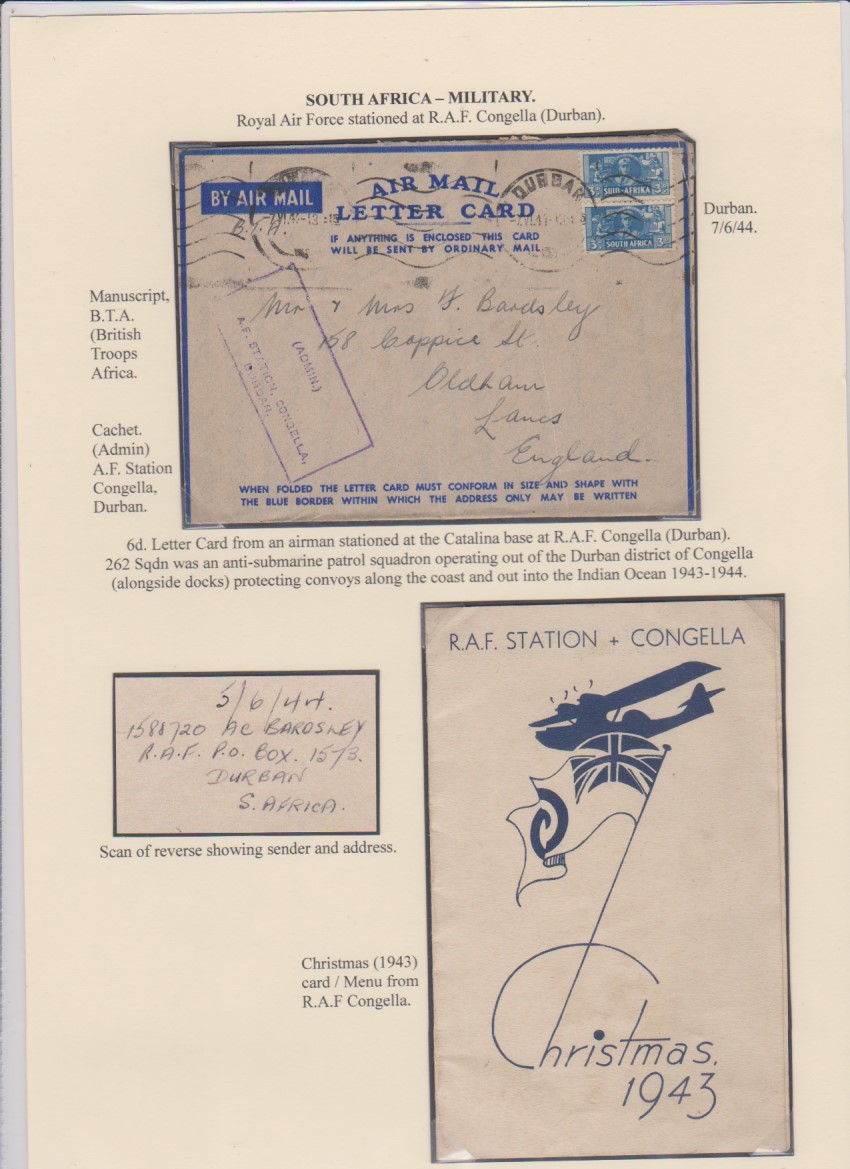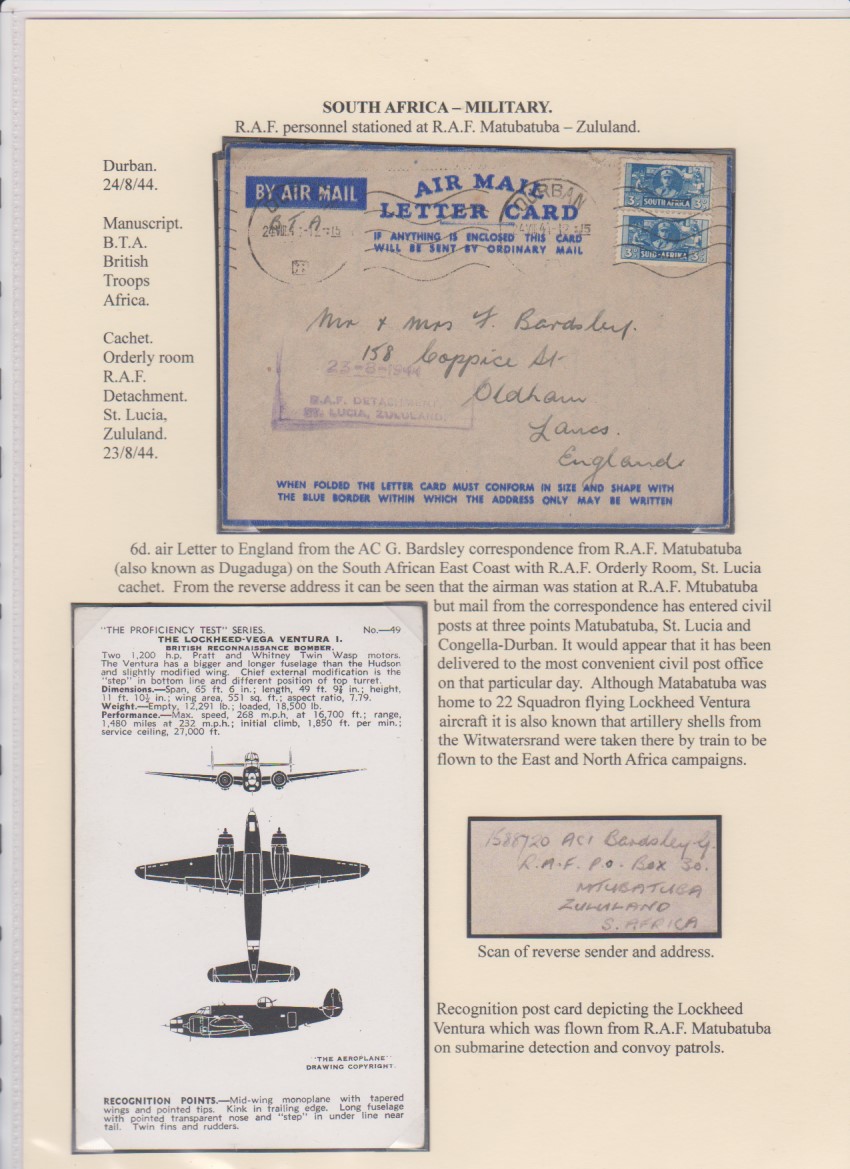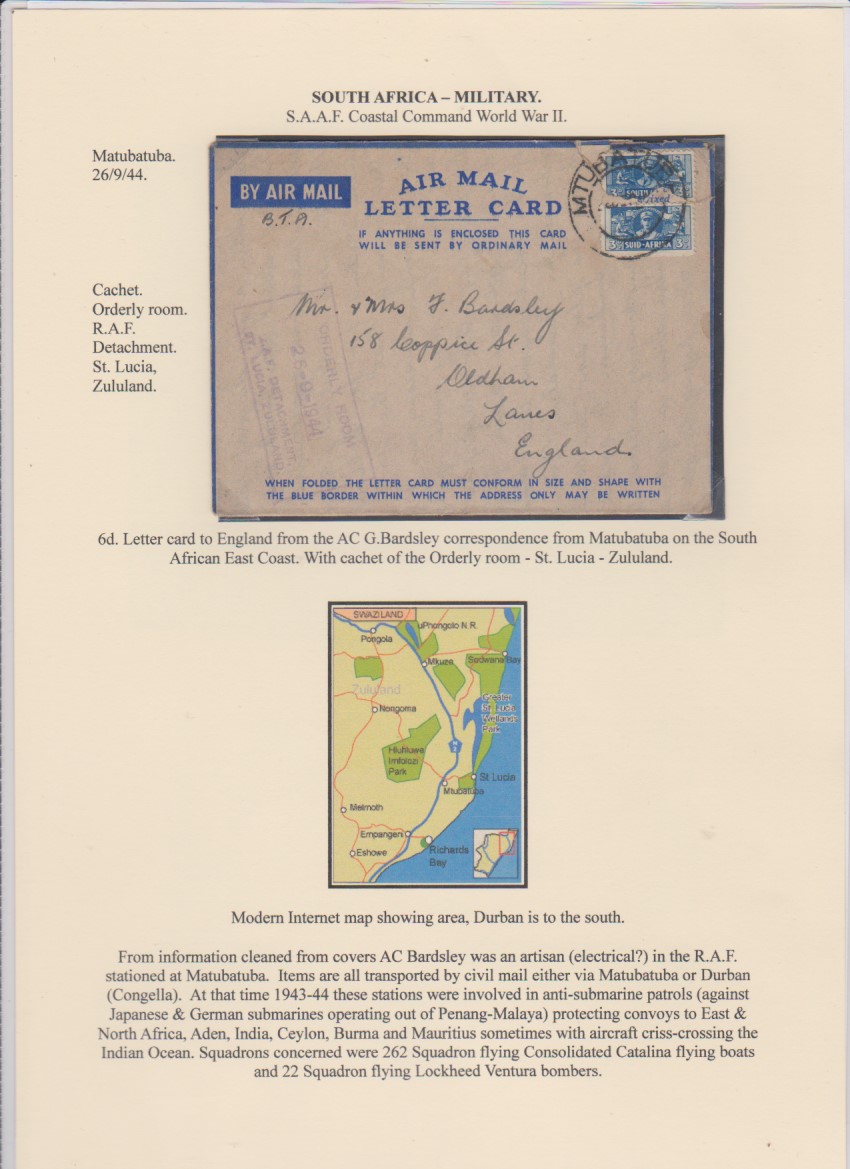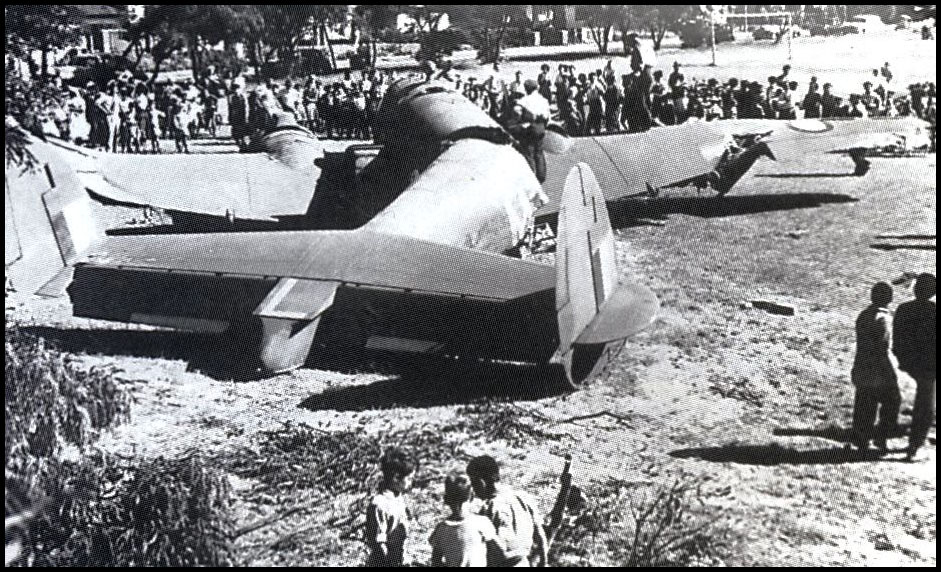Consolidated Catalina aircraft in South African waters WW2.
Quote from Jamie Smith on August 25, 2020, 4:14 pmWhen Steve originally asked me to put something up on his South African site I willingly agreed to help. When I saw what he did with it I was excited and so gave him more which he accepted and so it was that as time progressed I became nearly as involved as he was/is to the extent that without realizing it I became a founder member. What I saw and still see is a platform where we 'old timers' can place our exhibits, collections call them what you will, those collections will then outlive us. Our actual collections will eventually be broken up and sold on to those that follow us (that is if we do the groundwork for a future philatelic generation). What is left will be only those images floating around in space for those that follow us to study and put our knowledge into their collections.
There is a second side to this site, Articles, Questions, Answers, Thoughts, in other words, head knowledge that which we have read, seen, heard, gleaned and more important... been taught. I know what I was taught in the Pretoria Society and the Wanderers but how do I/we pass that information on to those who will follow? (Many of my fellow Wanderers have now passed on taking their knowledge with them). If I can give you an example of what is in my mind. I collect South African Military Postal History, into that vast subject come the Consolidated Catalinas that flew from Langebaan, Durban, St. Lucia and other places in South Africa to search the oceans around South Africa for enemy submarines and to protect convoys. Are there any left in South Africa? I am probably the only one that can answer that question!
Many years ago in my shop in Vereeniging a man walked in and we got into conversation. He told me that as a child he was out hunting crocodile with his father in the lakes and lagoons behind St. Lucia. He and his father watched as those wartime Catalines landed on a lake and were blown up, they now lie on the bottom of one of those lakes. Later I read that when the war finished the arrangement (conditions under which they were purchased) with America was that those planes and other military equipment around the world would be destroyed! Sinking them in that lake was the easiest and probably the cheapest way to do it. Not philately but history and connected to the covers that I have in my collection. If a museum wants a Catalina to restore they now know where they can find one. I have passed on my information!
What I am trying to say is, it is up to us! Do we want to record what we collected, together with the knowledge acquired in the process of putting that collection together or are we prepared to let it along with our hobby die? And in many cases... along with our life's savings!
When Steve originally asked me to put something up on his South African site I willingly agreed to help. When I saw what he did with it I was excited and so gave him more which he accepted and so it was that as time progressed I became nearly as involved as he was/is to the extent that without realizing it I became a founder member. What I saw and still see is a platform where we 'old timers' can place our exhibits, collections call them what you will, those collections will then outlive us. Our actual collections will eventually be broken up and sold on to those that follow us (that is if we do the groundwork for a future philatelic generation). What is left will be only those images floating around in space for those that follow us to study and put our knowledge into their collections.
There is a second side to this site, Articles, Questions, Answers, Thoughts, in other words, head knowledge that which we have read, seen, heard, gleaned and more important... been taught. I know what I was taught in the Pretoria Society and the Wanderers but how do I/we pass that information on to those who will follow? (Many of my fellow Wanderers have now passed on taking their knowledge with them). If I can give you an example of what is in my mind. I collect South African Military Postal History, into that vast subject come the Consolidated Catalinas that flew from Langebaan, Durban, St. Lucia and other places in South Africa to search the oceans around South Africa for enemy submarines and to protect convoys. Are there any left in South Africa? I am probably the only one that can answer that question!
Many years ago in my shop in Vereeniging a man walked in and we got into conversation. He told me that as a child he was out hunting crocodile with his father in the lakes and lagoons behind St. Lucia. He and his father watched as those wartime Catalines landed on a lake and were blown up, they now lie on the bottom of one of those lakes. Later I read that when the war finished the arrangement (conditions under which they were purchased) with America was that those planes and other military equipment around the world would be destroyed! Sinking them in that lake was the easiest and probably the cheapest way to do it. Not philately but history and connected to the covers that I have in my collection. If a museum wants a Catalina to restore they now know where they can find one. I have passed on my information!
What I am trying to say is, it is up to us! Do we want to record what we collected, together with the knowledge acquired in the process of putting that collection together or are we prepared to let it along with our hobby die? And in many cases... along with our life's savings!
Uploaded files:Quote from Steve on August 25, 2020, 6:57 pmMany thanks for the post, Jamie. And the sentiments. You have been the Star of this Show, a great contributor. We would not have got here without your support. I think we must upgrade your title (but not your pay) to that of Emeritus Founder Member.
Jamie mentions Lockheed Venturas. This is about them, not Catalinas. I grew up in Pinelands, Cape Town, under the flightpath of Ysterplaat Air Force Base. One of my earliest memories is of De Havilland Vampires screeching in overhead as my mother hung out the washing. Monday! Military aircraft have been on the periphery of my life ever since. Living in Cambridge one sees old planes often. The first Catalina I saw flying was at a nearby Duxford Airshow in about 2000. Ten days ago I saw a Hawker Hurricane flying around Madingley. That was a rare treat. Spitfires are common here.
During WW2, the SAAF received some 135 Ventura PV-1s, which were used to protect the sea lanes around the Cape of Good Hope and also to bomb Axis shipping in the Mediterranean. These twin-engined bombers were unpopular with aircrew as they had difficulty staying airborn on one engine, a major shortcoming in a light bomber. Some called them 'widow-makers'. Famously, in December 1942, SAAF Venturas dropped supplies to the survivors of the Dunedin Star which had been wrecked on a remote and inaccessible part of South-West Africa's Skeleton Coast. After one landed nearby and sank into the sand its crew joined the castaways. Venturas served in the SAAF until 1960.
As a boy I played cricket and soccer on Julianveld with my pals. It was at the bottom of Camp Road where I lived. One day while we were playing cricket a Lockheed Ventura experienced engine failure on take-off from Ysterplaat and crash-landed about 200 yards away from us in the nearby 'bush'. It descended over the railway station at Woltemade, crossed Jan Smuts Drive and came down in the 'bush', our adventure playground. The Ventura ploughed through the Port Jackson, burst through the surrounding fence, missed Jansie Grootwassink's house by a few feet and rampaged like a rhino across two busy-ish suburban roads, Morningside and Avonduur, not hitting a single car but taking down telephone poles and lines and digging up a furrow through the weak, sandy soil and coming to a dead halt on Julianveld no more than 50 yards from where we were playing and about the same distance from the nearest house.
We stood rooted to the spot, too awed to run. After some moments, the prop stopped spinning and there was a noise from inside the plane and a door opened in the fuselage on the near side. A little ladder dropped down. Most unexpectedly, a WAAF in a skirt slowly stepped out. She paused in the door to steady herself so that she could pull her shoe over her heel with one finger, then she stepped out followed by the crew. I was a boy then and not yet aware of women as objects of desire but she did that with real poise, like a movie star, a beauty with slim legs. The crew were shaken up and began smoking furiously like all Marlborough men did as soon as they were out. The pilot had done a great job of not crashing into a residential area, presumably with a full tank of gas. They should have given him a medal. But, I guess, you don't get medals for crashing well.
In the attached photo I may be the boy in the centre foreground in the picture. The haircut looks familiar, the standard short back and sides. I was poor at sports and usually just made up the numbers. Stephen Philips, a good spin bowler, appears to be on the left and Byron Reid, a good batsman, is possibly on the right. If it is not me, it could be Keith Bergset, a good footballer, rather than me in the centre. We were all playing together that day. It was a long time ago now. Keith lived on-site in the Ndabeni Industrial area where his Dad was a caretaker-manager at the Reckitt & Coleman Nugget Shoe Polish factory. I learned to swin in one of the factory's water reservoirs. I have a Pinelands Blue School class photo somewhere that includes all four of us. So, there you are, some history for posterity.
Many thanks for the post, Jamie. And the sentiments. You have been the Star of this Show, a great contributor. We would not have got here without your support. I think we must upgrade your title (but not your pay) to that of Emeritus Founder Member.
Jamie mentions Lockheed Venturas. This is about them, not Catalinas. I grew up in Pinelands, Cape Town, under the flightpath of Ysterplaat Air Force Base. One of my earliest memories is of De Havilland Vampires screeching in overhead as my mother hung out the washing. Monday! Military aircraft have been on the periphery of my life ever since. Living in Cambridge one sees old planes often. The first Catalina I saw flying was at a nearby Duxford Airshow in about 2000. Ten days ago I saw a Hawker Hurricane flying around Madingley. That was a rare treat. Spitfires are common here.
During WW2, the SAAF received some 135 Ventura PV-1s, which were used to protect the sea lanes around the Cape of Good Hope and also to bomb Axis shipping in the Mediterranean. These twin-engined bombers were unpopular with aircrew as they had difficulty staying airborn on one engine, a major shortcoming in a light bomber. Some called them 'widow-makers'. Famously, in December 1942, SAAF Venturas dropped supplies to the survivors of the Dunedin Star which had been wrecked on a remote and inaccessible part of South-West Africa's Skeleton Coast. After one landed nearby and sank into the sand its crew joined the castaways. Venturas served in the SAAF until 1960.
As a boy I played cricket and soccer on Julianveld with my pals. It was at the bottom of Camp Road where I lived. One day while we were playing cricket a Lockheed Ventura experienced engine failure on take-off from Ysterplaat and crash-landed about 200 yards away from us in the nearby 'bush'. It descended over the railway station at Woltemade, crossed Jan Smuts Drive and came down in the 'bush', our adventure playground. The Ventura ploughed through the Port Jackson, burst through the surrounding fence, missed Jansie Grootwassink's house by a few feet and rampaged like a rhino across two busy-ish suburban roads, Morningside and Avonduur, not hitting a single car but taking down telephone poles and lines and digging up a furrow through the weak, sandy soil and coming to a dead halt on Julianveld no more than 50 yards from where we were playing and about the same distance from the nearest house.
We stood rooted to the spot, too awed to run. After some moments, the prop stopped spinning and there was a noise from inside the plane and a door opened in the fuselage on the near side. A little ladder dropped down. Most unexpectedly, a WAAF in a skirt slowly stepped out. She paused in the door to steady herself so that she could pull her shoe over her heel with one finger, then she stepped out followed by the crew. I was a boy then and not yet aware of women as objects of desire but she did that with real poise, like a movie star, a beauty with slim legs. The crew were shaken up and began smoking furiously like all Marlborough men did as soon as they were out. The pilot had done a great job of not crashing into a residential area, presumably with a full tank of gas. They should have given him a medal. But, I guess, you don't get medals for crashing well.
In the attached photo I may be the boy in the centre foreground in the picture. The haircut looks familiar, the standard short back and sides. I was poor at sports and usually just made up the numbers. Stephen Philips, a good spin bowler, appears to be on the left and Byron Reid, a good batsman, is possibly on the right. If it is not me, it could be Keith Bergset, a good footballer, rather than me in the centre. We were all playing together that day. It was a long time ago now. Keith lived on-site in the Ndabeni Industrial area where his Dad was a caretaker-manager at the Reckitt & Coleman Nugget Shoe Polish factory. I learned to swin in one of the factory's water reservoirs. I have a Pinelands Blue School class photo somewhere that includes all four of us. So, there you are, some history for posterity.
Uploaded files:



